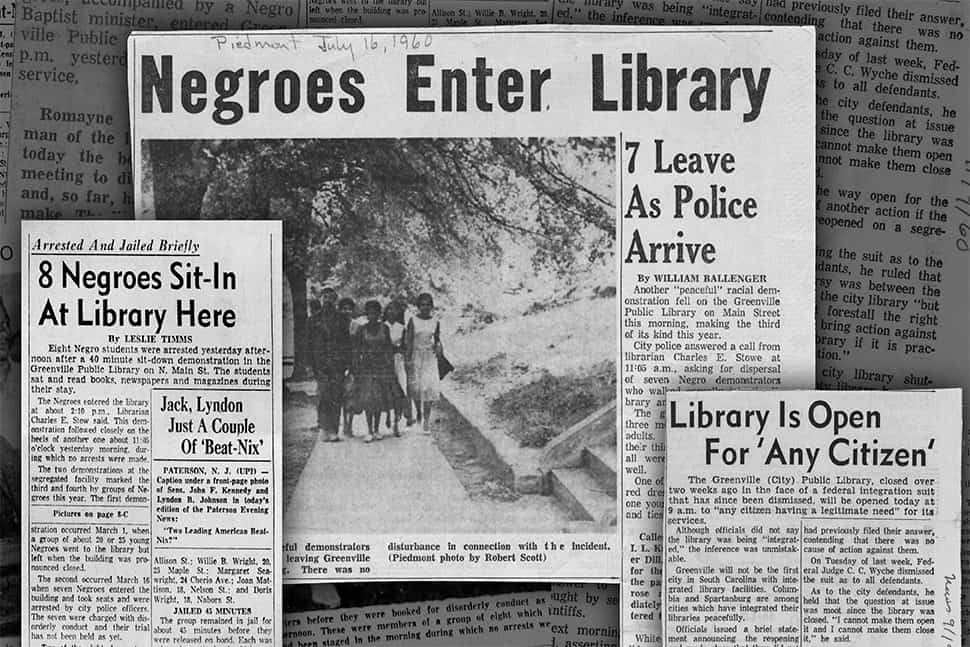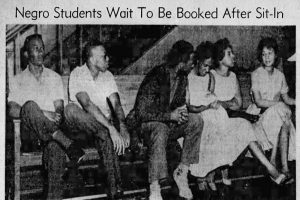
Over the past six decades, the media, local and state governments, professional associations, and civic organizations of all kinds have apologized for doing little or nothing while black people were beaten, jailed, and sometimes killed for standing up for their civil rights. The numerous confrontations over integrating public libraries in the South, however, have largely gone unrecognized.
It’s long past time that library organizations and individual libraries do something to recognize the black kids—many of them still alive like Joan Mattison Daniel—who risked their lives at this critical time. Here are some of their stories.
The Tougaloo Nine

At 11 a.m. on March 27, 1961, nine students from the historically black Tougaloo College walked into the all-white Jackson (Miss.) Public Library. Joseph Jackson Jr., their leader, approached the circulation desk. With heart thumping, he stammered a message he had memorized: “Ma’am, I want to know if you have this philosophy book. I need it for a research project.”
“You know you don’t belong here!” the library assistant yelled, proceeding to call the library director.
“May I help you?” the latter asked, coming out of her office.
“We’re doing research,” the students responded.
“There’s a colored library on Mill Street,” she said. “You are welcome there.”
Almost immediately, Jackson later reported, police entered the building and told the students to get out of the library. No one moved. The chief of police then told them that they were under arrest.
Six officers placed the students into squad cars and at the station charged them with breach of the peace because they failed to leave the library when ordered. They were booked into the local jail, where each was held on $500 bond.
In jail that evening, the students worried. “Reflecting back on Emmett Till [murdered in 1955] and the history of lynching connected with Mississippi,” Jackson related in 2015 to writer Gabriel San Román in the Orange County (Calif.) Weekly, “the later it got that night, I was in fear of my life.” He began rehearsing what he would say if the Ku Klux Klan came for them: “Please, Mr. Klansman, don’t hang me. I have a wife and two little children in Memphis, and if you release me this night, I promise you I will never, ever come back here to Jackson and violate your Jim Crow laws.”
His colleagues laughed at his naiveté. “You know what the Klansman would say?” one said. “‘Nigger, you should have thought of that before you entered our segregated public library!’”
Several days later, the students were taken to the courthouse to be tried. Several blocks away, hundreds of whites were marching through city streets under a huge Confederate flag. At the courthouse, however, some 100 black supporters had gathered to cheer what were now referred to as the “Tougaloo Nine.” Fourteen police officers and two German shepherds lined the courthouse stairs.
When the crowd began to applaud the nine students as they arrived, the police chief yelled, “That’s it! Move ’em out! Get ’em!” Police set upon the crowd with nightsticks and dogs. During the melee, Medgar Evers (secretary of the Mississippi chapter of the National Association for the Advancement of Colored People [NAACP], who would be assassinated two years later) and several women and children were pistol whipped, two black ministers were bitten by the dogs, and an 81-year-old man who went to the courthouse only to hear the case suffered a broken arm when police beat him with a club.
The brutality exercised on black people supporting the library protesters in Jackson, Evers later argued, set in motion broader desegregation activities in Mississippi. “This act on the part of the police officials brought on greater unity in the Negro community and projected the NAACP in a position of being the accepted spokesman for the Negro people,” he wrote in his autobiography.
The St. Helena Four
On March 7, 1964, four black teenagers—including Alton Crier, Sterling Hall, and David Howard (the fourth’s name was never entered into the record)—approached the St. Helena branch of the Audubon Regional Library in Greensburg, Louisiana. The librarian saw them coming, recognized what was happening, immediately locked the door, and posted “closed” signs in the window. The four left.
“The street was crowded with Negroes and whites,” noted an observer for the Congress of Racial Equality (the activist organization that had helped plan the sit-in), while most of the town’s white merchants were standing on the sidewalk talking with spectators. Four days later, the youths returned and met the same response. Through the window, they saw the librarian make a phone call as they approached. Moments later she unlocked the door, came out, relocked it, and left.
On March 13, the four teenagers made a third attempt, deciding to pair off rather than approach as a foursome. As two walked in front of the drugstore across the street, the pharmacist came out and said, “I’m sorry, boys, but you are too late. Come back tomorrow and you may have better luck.” As they left, however, he added: “I wish you ———— niggers would come to my place.” *
When the pair crossed the street to meet the other two who were approaching the library from a different direction, they learned it was again locked against them. They decided instead to walk to the courthouse, where, without incident, they drank from the “white” water fountain.
When they walked back past the drugstore, the pharmacist came out the door. “I am tired of fooling with you ———– niggers,” he shouted, then rushed to his car and pulled out a .32-caliber automatic pistol. “Git away from here, and I don’t mean maybe.” The youths fled.
On a fourth attempt three days later, the group once again found the library closed. This time they walked to the courthouse, where they again drank from the “white” water fountain. Quickly, however, a white janitor grabbed one of the teens and shouted, “There’s a fountain over there for the niggers, and if you ———– niggers can’t drink from that fountain, get out of here, and don’t be caught back in here no more.” He then called for help from a friend upstairs. “Come down here and help me get these ———– niggers out of here.”
When the group walked to the courthouse front steps, the janitor grabbed a lead pipe, saying, “If you ———– niggers come back here again, I will kill every one of you.” At that point he struck one of the boys with the pipe. The boy was taken to a local hospital, treated, and released.
Days later, several white merchants tried to intimidate the parents of the protesters by asking if they knew their sons were trying to use the library.
Remembrance
These are but two of the many ultimately successful protests that resulted in the integration of public libraries in the Jim Crow South. Hundreds of young public library protesters have gone largely unrecognized for their acts of courage.
When I mentioned to some librarian colleagues in the South that I was looking into the history of public library desegregation, one asked, “You mean Southern public libraries were segregated at one time?” Another suggested I lecture to his class on the heroic defense he assumed that public librarians put up against segregated services. Both had assumed that librarianship’s 21st-century core values of defending intellectual freedom and serving all members of the community equally had always existed.
This blind spot in our history is long overdue for a reexamination. Public librarians can consult old local newspapers to find the names of protesters who participated in this unsung saga, check to see if they are still alive, and give them the thanks that they deserve.
* Editor’s note: Quotes, including omissions of language, have been taken directly from historical affidavits.

 WAYNE A. WIEGAND is F. William Summers professor of library and information studies emeritus at Florida State University. He has also written “‘Any Ideas?’ The American Library Association and the Desegregation of Public Libraries in the American South,” Libraries: History, Society, Culture (March 2017). He is coauthor, with Shirley Wiegand, of The Desegregation of Public Libraries in the Jim Crow South: Civil Rights and Local Activism (Louisiana State University Press, spring 2018). To obtain a list of public library protesters covered in the book, contact him at
WAYNE A. WIEGAND is F. William Summers professor of library and information studies emeritus at Florida State University. He has also written “‘Any Ideas?’ The American Library Association and the Desegregation of Public Libraries in the American South,” Libraries: History, Society, Culture (March 2017). He is coauthor, with Shirley Wiegand, of The Desegregation of Public Libraries in the Jim Crow South: Civil Rights and Local Activism (Louisiana State University Press, spring 2018). To obtain a list of public library protesters covered in the book, contact him at 
